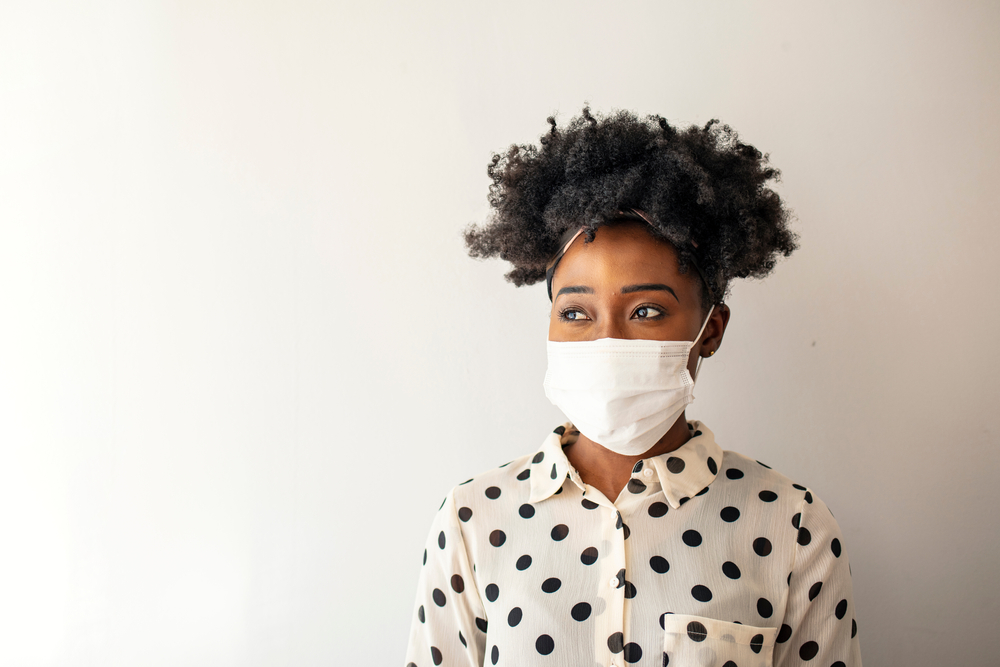
Image Credit: Dragana Gordic/Shutterstock.com
The COVID-19 pandemic has swept the globe incredibly quickly, with the novel coronavirus having affected 53,178,525 people worldwide as of 13th November 2020. While face masks have always been common in Asian countries during winter, they are now widespread in almost every country; it now seems normal to put on a face mask before entering a public space.
As the virus is a respiratory disease mainly transmitted through nanoscale aerosol droplets, cloth masks, and face coverings act as a suitable barrier, filtering out the harmful particles released when someone coughs or sneezes. Theoretically, wearing a face mask can help reduce the spread of disease.
However, face masks also present a health hazard as the material can become contaminated. The live viruses and bacteria attached to the mask’s surface could still be infectious and easily transferred from mask to hand to surfaces by merely touching the material or when removing the mask.
Can Sunlight Disinfect Ordinary Face Masks?
Early on in the pandemic, it was widely reported that sunlight or a high temperature could disinfect face masks. This theory was quickly debunked by the World Health Organization (WHO), who said neither could cure or prevent COVID-19.
The theory that the sunlight can kill the virus stems from ultraviolet (UV) light’s sanitization properties; it has been used to disinfect buses and hospitals, for example, and could be applied to disinfecting personal protective equipment (PPE) ready for reuse.
UV-C is an incredibly powerful wavelength of light, often referred to as germicidal UV. It can eradicate viral genetic material by disrupting its DNA, preventing it from functioning correctly and reproducing. However, as much of the UV-C is blocked out by the ozone layer, leaving an ordinary mask out in the sun will not disinfect it.
New Material Disinfected by Sunlight
Although regular face masks cannot be sanitized with sunlight, a newly developed cotton fabric capable of killing 99.9999% of bacteria and viruses with just 60 minutes of exposure to daylight could be used for reusable and sustainable PPE such as face masks and protective suits, say researchers from the University of California, Davis.
When exposed to daylight, the novel antimicrobial fabric releases reactive oxygen species (ROS) – an unstable molecule containing oxygen that easily reacts with other molecules, killing microbes attached to the fabric surface.
The fabric was created by attaching positively charged chains of 2-diethyaminoethyl chloride (DEAE-Cl) to regular cotton and dyeing it in a solution of negatively charged photosensitizer. The photosensitizer adheres to the DEAE chains via strong electrostatic interactions and releases ROS when exposed to light. The ROS damage the bacterial/viral protein RNA, DNA, and lipids of microorganisms, resulting in rapid inactivation.
Fabric, which utilized the dye rose Bengal – a class of organic compounds called xanthenes - as a photosensitizer killed 99.9999% of bacteria added to the material within one hour of daylight exposure. This included the gram-negative bacteria E. coli and the gram-positive bacteria Listeria innocua; effectiveness against both types of bacteria is essential, particularly in healthcare settings.
The fabric also inactivated 99.9999% of T7 bacteriophage, a model virus target thought to be more resistant to ROS than some coronaviruses, within half an hour.
Further tests revealed the material could be hand washed at least ten times before losing its antimicrobial activity and continuously exposed to daylight for at least seven days. Theoretically, a person could disinfect their face mask by placing it in the sun during their lunch hour or longer under the office lights (as they are much less intense).
This work demonstrated that the cationized cotton could serve as a platform for different functionalization applications, and the resulting fiber materials could inspire the development of reusable and sustainable PPE with significant bioprotective properties to fight the Covid-19 pandemic as well as the spread of other contagious diseases."
University of California, Davis
The material – fabricated via a simple chemisorption process – can be scaled up for industrial and mass production and shows excellent potential for producing reusable, antibacterial, and antiviral face masks and protective suits with enhanced biological protections compared with that of traditional PPE.
The Value of PPE
PPE's importance cannot be understated; face masks, protective suits, and face shields can help lower disease spread. However, current PPE can only protect against those pathogens with a limited lifespan – any live, infectious pathogens present on their surface can cause cross-contamination during removal and reuse.
The development of a new fabric capable of killing bacteria and viruses simply with sunlight – and the fact that it can be scaled up for mass production - offers promise for reusable and sustainable antibacterial and antiviral face masks and protective suits, and could prevent the plethora of single-use products littering the landscape.
References and Further Reading
American Chemical Society (2020) Cloth face masks that can be disinfected by the sun. ScienceDaily [Online] Available at: www.sciencedaily.com/releases/2020/11/201111144407.htm Accessed 12th November 2020.
Tang P et al. (2020) Daylight-Induced Antibacterial and Antiviral Cotton Cloth for Offensive Personal Protection, ASC Applied Materials & Interfaces https://doi.org/10.1021/acsami.0c15540 Accessed 12th November 2020.
Worldometer (2020) Covid-19 Coronavirus Pandemic [Online] Available at: https://www.worldometers.info/coronavirus/ Accessed 13th November 2020.
Disclaimer: The views expressed here are those of the author expressed in their private capacity and do not necessarily represent the views of AZoM.com Limited T/A AZoNetwork the owner and operator of this website. This disclaimer forms part of the Terms and conditions of use of this website.